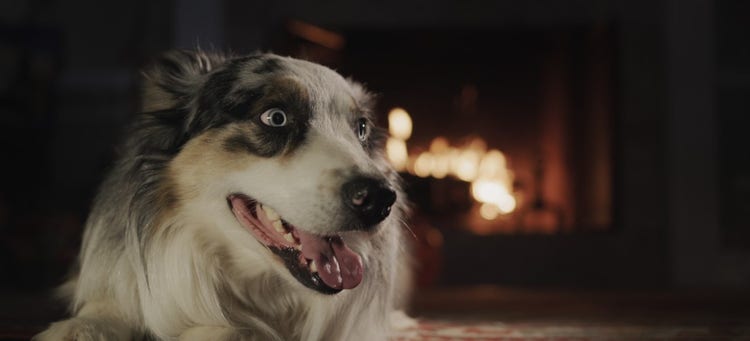
Dog Panting at Night: Is it Normal or a Sign of Illness?
A dog panting at night is often a physiological reaction to warm weather, physical exertion, or mild stress. Sometimes though, that breathlessness means something more serious is happening. There are several reasons dogs pant at night, ranging from innocuous to urgent. We developed this guide to help you understand the differences.
Is It Normal for Dogs to Pant at Night?
Panting is a way for dogs to remove heat from their body. They don’t have a large number of sweat glands like we do, so they pant to cool down.
Panting can also be a reaction to sudden noises (like thunderstorms or fireworks), and other forms of stress. When stressed, dogs release the hormone cortisol to help keep them alert. Excess cortisol increases metabolism, which raises the body’s temperature.
Why Is My Dog Panting and Restless at Night? Common Causes
Normal or Mild Causes
These are the most common reasons dogs pant at night.
- The room is too warm. Panting is the primary way dogs cool down. Reducing the temperature by a few degrees may be all that’s needed to resolve the issue.
- Recent exercise or excitement. Physical exertion increases the body’s metabolic rate, which generates heat. You may notice your dog panting more, for example, as they run up the steps to greet a favorite human.
- Dreaming during REM sleep. During vivid dreaming, a dog may perceive a threat. This triggers a surge of adrenaline, which increases the breathing rate.
- Mild stress or routine change. Because dogs are creatures of habit, any seemingly innocuous change (like a new mealtime) can cause stress. Situational stress, brought on by things like fireworks or thunderstorms, may also be factors.
Potentially Concerning Causes
Excessive panting in dogs at night can sometimes signal a more serious health or behavior issue. If in doubt, it’s always best to check with your veterinarian.
- Pain or discomfort. Being in pain (whether it’s caused by arthritis, injuries, gastrointestinal upset, or some other malady) causes the heart to beat more quickly, which in turn leads to heavier panting.
- Stress or separation anxiety. Panting can be a sign that a dog is suffering from separation anxiety (the fear of being left alone) or another form of anxiety.
- Cognitive dysfunction in senior dogs. Some older dogs develop cognitive dysfunction (CD), a condition akin to dementia in humans. One of the signs of CD is excessive panting.
- Heart disease. Diseases like dilated cardiomyopathy (DC) cause the heart to enlarge, making it less efficient at pumping blood and oxygen. Panting is a way to compensate for this.
- Respiratory issues. When a dog’s respiratory system isn’t functioning as it should, oxygen can’t move adequately through the body. Dogs with short noses and flat faces (brachycephalic breeds), like Pugs and French Bulldogs are more prone to respiratory issues.
- Cushing’s disease. This disease manifests when a dog’s adrenal tissue produces excess amounts of cortisol, which in turn increases metabolism, and with it, a rise in body temperature.
- Fever or infection. An infection that causes pneumonia, for example, makes it difficult for the body to get sufficient oxygen. Panting is an attempt to produce more oxygen flow.
- Toxin exposure. Insecticides, human medications, antifreeze, and other toxins can ravage the heart and respiratory system, as well as cause pain and discomfort. If you suspect your dog has ingested a toxin, it’s imperative to contact your veterinarian immediately.
Dog Anxiety Panting: How to Calm an Anxious Dog at Night
Ask your veterinarian if any of these ideas might be a good fit for your dog.
- Background noise. Professionals recommend using the television, white noise, or classical music to distract from loud noises. Or consider a sound therapy app designed for pets, like Zoundz.
- Calming pheromones. Available as diffusers, sprays, wipes, and collars, pheromones work by mimicking calm-inducing scents, like that of a mother dog.
- Compression shirts. Products like Anxiety Wrap and Thundershirt apply gentle pressure to the dog’s body. The theory is that they act as a warm, comforting embrace.
When to Call the Vet About Nighttime Panting
Excessive panting in dogs at night can indicate a more serious health issue. Call your veterinarian if you notice any of the following.
Warning Signs That Require Urgent Attention
- Panting + vomiting or diarrhea
- Panting + collapse, blue gums, rapid heart rate
- New or worsening panting in older dogs
- Panting that persists for hours or disrupts sleep consistently
Veterinarians recommend keeping a journal and video diary of your dog’s symptoms.
How Vets Diagnose the Cause of Panting
To determine if an underlying illness is behind the panting, your veterinarian will perform an exam and diagnostics. Here is some of what you might expect:
- A physical exam. Includes listening to the heart and lungs and checking for signs of pain or injury, as well as taking the temperature to check for an infection.
- Bloodwork and imaging. This might include a complete blood count, urinalysis, and biochemical panel. Your veterinarian may also run an ACTH stimulation test to rule out Cushing’s disease and an endocrine panel to check for hormonal imbalances.
- Advanced testing. These may include an X-ray to check for broken bones or foreign objects and an ultrasound for a more comprehensive look at internal organs. Advanced diagnostics might include a bronchoscopy, computed tomography (CT scan), or magnetic resonance imaging (MRI). Your veterinarian may also run a cardiac or neurological evaluation.
Tips to Help Your Dog Sleep Better at Night
- Keep the Environment Cool
- Provide a Quiet and Relaxing Environment
- Maintain a Calming Bedtime Routine
- Address Pain or Anxiety with Vet-Approved Solutions
- Ask Your Veterinarian If Supplements Might Help
- Avoid Feeding or Overexertion Too Close to Bedtime